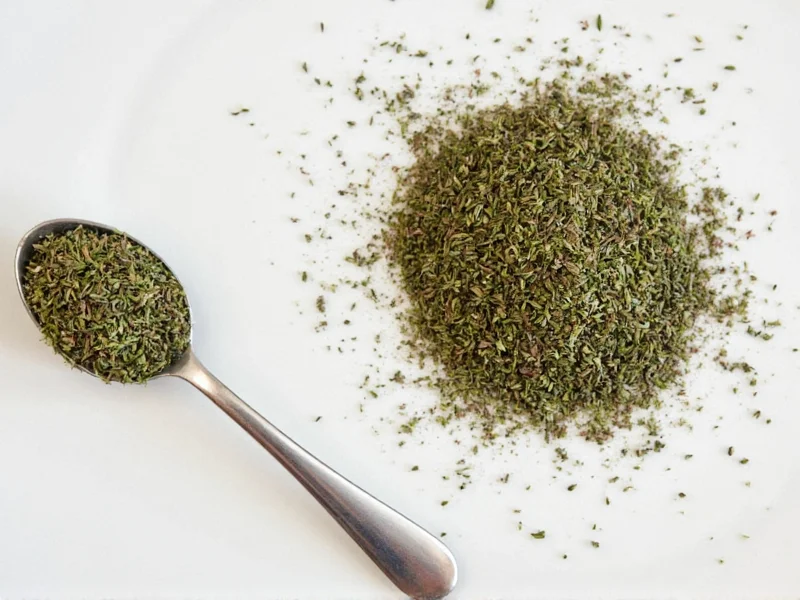When substituting dried thyme for fresh in your recipes, understanding the proper conversion ratio is essential for achieving balanced flavors. The general rule across culinary professionals is that dried herbs are about three times more potent than their fresh counterparts because the drying process removes water content while concentrating essential oils and flavor compounds.
Why the 3:1 Fresh to Dried Herb Ratio Matters
Thyme, like most herbs, undergoes significant chemical changes when dried. Fresh thyme contains approximately 85% water, which evaporates during drying, leaving behind a more concentrated form of the herb's essential oils and flavor compounds. This concentration effect means you need less dried thyme to achieve similar flavor intensity as fresh.
When a recipe calls for 2 teaspoons of fresh thyme, using the full 2 teaspoons of dried thyme would result in an overpowering, potentially bitter flavor that could ruin your dish. The correct conversion ensures your culinary creations maintain the intended flavor profile.
Thyme Conversion Reference Guide
| Fresh Thyme | Dried Thyme | Best For |
|---|---|---|
| 1 teaspoon | 1/3 teaspoon | Delicate sauces, finishing dishes|
| 2 teaspoons | 2/3 teaspoon | Most standard recipes, soups, stews|
| 1 tablespoon | 1 teaspoon | Robust dishes, long-cooking recipes|
| 1/4 cup | 1 tablespoon + 1 teaspoon | Large batch cooking, preserving
Practical Substitution Tips for Cooking
When converting fresh thyme measurements to dried in your recipes, consider these professional kitchen insights:
- Timing matters: Add dried thyme earlier in the cooking process than fresh thyme, as it needs time to rehydrate and release its flavors. For soups and stews, add dried thyme at the beginning, while fresh thyme should be added in the last 10-15 minutes.
- Quality affects potency: Older dried thyme loses potency over time. If your dried thyme is more than 6 months old, you might need to increase the amount slightly.
- Taste as you go: Especially when substituting, taste your dish before serving and adjust seasoning if needed.
- Consider the dish type: For delicate dishes like fish or egg preparations, use slightly less dried thyme (try a 4:1 ratio instead of 3:1) to prevent overpowering subtle flavors.
Understanding Thyme Varieties and Their Impact
Not all thyme is created equal, which affects conversion considerations:
Common garden thyme (Thymus vulgaris) follows the standard 3:1 conversion ratio. However, lemon thyme and other specialty varieties may have different potency levels due to varying essential oil compositions. When working with specialty thyme varieties, start with a slightly smaller amount of dried herb and adjust to taste.
Proper storage significantly impacts dried thyme's potency. Store dried thyme in an airtight container away from light and heat. Well-stored dried thyme maintains optimal flavor for 6-12 months, after which you may need to increase quantities slightly to achieve the same flavor intensity.
When Precision Matters Most
Certain culinary applications demand particularly careful attention to thyme measurements:
- Baking: In breads and savory pastries where chemical reactions are precise, accurate herb measurements affect both flavor and texture.
- Preserving: When making herb-infused oils or vinegars, incorrect ratios can impact both flavor and safety.
- Sauces and dressings: In emulsified sauces where balance is critical, thyme quantity affects the entire flavor profile.
- Meat rubs: Too much dried thyme can become bitter when exposed to high heat.
For professional results, consider investing in a small digital scale for measuring dried herbs by weight rather than volume, as this provides more consistent results across different batches of dried thyme.
Common Mistakes to Avoid
Many home cooks make these errors when substituting dried for fresh thyme:
- Using equal measurements (1:1 ratio) resulting in overpowering flavors
- Adding dried thyme too late in the cooking process, preventing proper flavor development
- Not accounting for the age of dried herbs, which lose potency over time
- Crushing dried thyme between fingers before adding (this releases too much oil at once)
- Storing dried herbs in clear containers where light degrades quality











 浙公网安备
33010002000092号
浙公网安备
33010002000092号 浙B2-20120091-4
浙B2-20120091-4